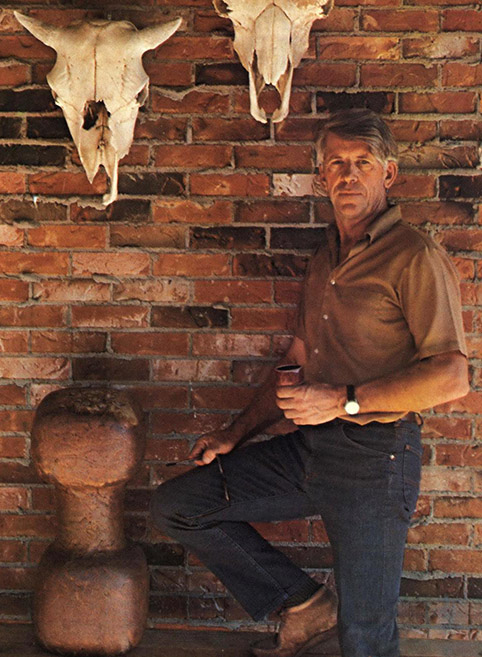| Monthly Tech-Tip | No tracking! No ads! | |
Measuring clay test bars done by Luke Lindoe 40 years ago
Luke Lindoe prospected Montana and Idaho for clays during the 1970s. He found an amazing variety of fireclays, earthenwares and stonewares. Every color, texture, plasticity. For each he made test bars to fire at different temperatures. Our M2 and Troy clays originated from this work. We just found these bars, but do not have Luke's shrinkage and porosity data, so are measuring them now. He code-numbered each and stamped them with four-inch marks. So we can derive the total fired shrinkages and measure the porosities. We can tell a lot about the plasticity of each by the nature of the cut lines. The texture also is obvious. Now we just need to start searching Luke's map archives to find out where all of these are.
Related Pictures
Mosaic mural in Dan McCharles Park - made by Luke Lindoe in 1961

This picture has its own page with more detail, click here to see it.
The mural is made from unglazed stained stoneware tiles, each cut to shape. The inscription reads: "THE DOCTOR OF TODAY TAKES HIS PLACE AT THE HEAD OF A VERY LONG LINE OF DISTINGUISHED PREDECESSORS; THE KNOWLEDGE AND TRADITION THAY MAKES THE MEDICAL PROFESSION WHAT IT IS TODAY GROWS FROM
THE GREAT DOCTORS OF THE NINETEENTH CENTURY AND OF MEDIEVAL EUROPE, OF GREECE, OF EGYPT AND BEYOND - LOST IN THE PAST. THIS MOSAIC PAYS TRIBUTE TO THAT VAST HISTORY."
John Porter’s fired glaze samples are being catalogued

This picture has its own page with more detail, click here to see it.
John Porter was a prolific glaze tester and developer, both in reduction and oxidation firing. We shot and cataloged hundreds of pictures of a treasure trove of glaze samples of his testing from the 1970s to the 1990s. Among them are also a few samples done by Luke Lindoe. Each of the many hundreds of specimens was code-numbered to index into John's meticulous notes. This was a time when most pottery was done at temperatures where little frit was needed, glazes were made of raw minerals. Hopefully, more cataloguing of our archives will uncover more of his notes and provide clues and information to derive more of the recipes of these.
Large sculpture by Luke Lindoe - 1967

This picture has its own page with more detail, click here to see it.
This is housed on the lower floor of the Medicine Hat public library. It is a testimony to the skill Luke Lindoe, this heavy piece has no visible cracks. Made at the time Plainsman Clays was just starting. Luke did not have a high-temperature red burning clay to be able to make the warm colors of H440, for example (this employs the clays available in the I-XL Brick suite of raw materials). He did have materials mined around Elkwater, two of them he could have used were 45R, a low-fire red similar to BGP, and 45D, a medium-fire plastic material. These types of materials would have limited firing temperature to around cone 2. But Luke would also have been aware of the more refractory clays around Ravenscrag, Sask and could have been processing them himself - that would have enabled a high-temperature body for gas firing in a reduction atmosphere.
Luke Lindoe in 1971

This picture has its own page with more detail, click here to see it.
He was the founder of Plainsman Clays. My dad had just built the Plainsman Clays factory for him and I began working there in 1972 (this picture was taken at his house, which my father also built). He was a well-known artist potter and sculptor at the time, having come out of the pottery production industry in the area. He got me started along the fascinating road of understanding the physics of clays. He was a true "plains man", interested in the geology of the plains (notice the skulls, these inspired the Plainsman logo). He got me started doing physical testing of raw clays (that he was finding everywhere). I was blown away by the fact that I could assess a completely new material and judge its suitability for many types of ceramic products and processes by doing the simple physical tests he showed me. It got started writing software to log the data for that back in the 1980s, that eventually led to digitalfire.com and Insight-live.com.
Got a Question?
Buy me a coffee and we can talk

https://digitalfire.com, All Rights Reserved
Privacy Policy

